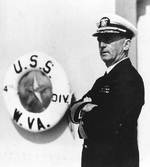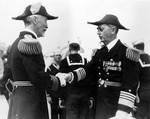William Leahy
| Surname | Leahy |
| Given Name | William |
| Born | 6 May 1875 |
| Died | 20 Jul 1959 |
| Country | United States |
| Category | Military-Sea |
| Gender | Male |
Contributor: C. Peter Chen
ww2dbaseWilliam Daniel Leahy was born in Hampton, Iowa, United States. He graduated from the United States Naval Academy at Annapolis in 1897. As a junior officer aboard the battleship Oregon, he participated in the Battle of Santiago during the Spanish-American War. Around the turn of the century, he served with the Asiatic Fleet and commanded the gunboat USS Mariveles. After several postings both home and abroad, he briefly served in WW1 as the captain of USS Princess Matotika and transported American troops to Europe. His career grew at a steady rate during the inter-war years with him holding progressively greater commands. In 1933, he became the Chief of the Bureau of Navigation, then in 1936, now a vice admiral, he was named the Commander in Chief of the Navy's Battle Force with his flag aboard battleship California. In Jan 1937, he was named the Chief of Naval Operations. He retired from the Navy in 1939; upon which occasion, his long-time friend Franklin Roosevelt told him that, "Bill, if we have a war, you're going to be right back here helping me run it." After his retirement, he was sent to Puerto Rico as its governor then later to Vichy France as the American ambassador.
ww2dbaseAs war wore on, Roosevelt felt more and more pressure to have a trusted naval officer at his side as his advisor during strategic conferences. On 6 Jul 1942, with George Marshall and Ernest King's approval, Leahy was reactivated by Roosevelt and was named the President's Chief of Staff (or, officially, Chief of Staff to the Commander in Chief of the Army and Navy). On 15 Dec 1944, he became the first American naval officer to hold the rank of fleet admiral. After the destruction of Hiroshima and Nagasaki by atomic bombs, he expressed disapproval on the decision. "[I]n being the first to use it, we had adopted an ethical standard common to the barbarians of the Dark Ages", he said. "I was not taught to make war in that fashion, and wars cannot be won by destroying women and children."
ww2dbaseLeahy resigned from the Navy in Mar 1949. He died at Bethesda Naval Hospital on 20 Jul 1959.
ww2dbaseSource: Wikipedia.
Last Major Revision: Aug 2006
William Leahy Interactive Map
Photographs
 |  |  |  |
Videos
 |
William Leahy Timeline
| 6 May 1875 | William Leahy was born in Hampton, Iowa, United States. |
| 1 Jul 1899 | William Leahy was promoted to the rank of ensign. |
| 1 Jul 1902 | William Leahy was promoted to the rank of lieutenant junior grade. |
| 31 Dec 1903 | William Leahy was promoted to the rank of lieutenant. |
| 3 Feb 1904 | William Leahy married Louise Tennent Harrington. |
| 15 Sep 1909 | William Leahy was promoted to the rank of lieutenant commander. |
| 18 Oct 1911 | William Leahy served as naval aide to US President William Howard Taft at the keel laying ceremony of USS Jupiter, at Mare Island Navy Yard, Vallejo, California, United States. |
| 29 Aug 1916 | William Leahy was promoted to the rank of commander. |
| 1 Jul 1918 | William Leahy was promoted to the rank of captain. |
| 14 Oct 1927 | William Leahy was promoted to the rank of rear admiral. |
| 13 Jul 1935 | William Leahy was promoted to the rank of vice admiral. |
| 2 Jan 1937 | William Leahy was promoted to the rank of admiral. |
| 23 Nov 1940 | It was announced in the United States that Admiral William Leahy was to be appointed Ambassador to France in place of Mr. William Bullitt. |
| 3 Mar 1941 | Admiral William Leahy, US Ambassador to Vichy France, secured an agreement from the Vichy government to deny the Axis any oil from French North Africa. |
| 21 Apr 1942 | William Leahy's wife Louise Tennent Harrington Leahy passed away from a post-surgery embolism in France, with Leahy at her side. She would later be buried at the Arlington National Cemetery in Virginia, United States. |
| 6 Jul 1942 | Franklin Roosevelt ordered US Ambassador to France William Leahy to return to the United States to serve as Roosevelt's military chief of staff. |
| 21 Jul 1942 | William Leahy officially took his position as US President Franklin Roosevelt's chief of staff. |
| 15 Dec 1944 | William Leahy was promoted to the rank of fleet admiral. |
| 9 Jan 1946 | William Leahy informed Harry Truman that Truman's disbanding of the Office of Strategic Services (OSS) had been handled in a "disgraceful way", for that the overly-rapid schedule had caused the US to lose sources of intelligence across the world. |
| 20 Jul 1959 | William Leahy passed away at the US Naval Hospital in Bethesda, Maryland, United States. |
| 22 Jul 1959 | The viewing of William Leahy's remains began at the Bethlehem Chapel at the Washington National Cathedral, Washington, United States. |
| 23 Jul 1959 | The view of William Leahy's body at the Bethlehem Chapel at the Washington National Cathedral, Washington, United States ended at 1200 hours. A Special Military Funeral for him was given at 1400 hours at the cathedral. Later in the afternoon, he was buried at the Arlington National Cemetery in Virginia, United States. Chester Nimitz, Thomas Hart, Charles Snyder, Louis Denfield, Arthur Radford, Edward Cochrane, Henry Williams, Jerauld Wright, Robert Dennison, Joseph Wellings, and William Hassett served as pallbearers. |
Please consider supporting us on Patreon. Even $1 per month will go a long way! Thank you. Please help us spread the word: Stay updated with WW2DB: |
Visitor Submitted Comments
20 Jul 2015 05:57:49 AM
The timeline says Leahy retired from the Navy on 20 Jul 1942, but that is the day on which the Navy says he became Chief of Staff to the Commander in Chief of the Army and the Navy, the precursor to the post of Chairman of the Joint Chiefs of Staff. Your own timeline shows he was active well after this date. There is something wrong with the timeline statement.
20 Jul 2015 07:23:10 PM
Thank you, the incorrect timeline entry has been fixed.
9 Sep 2015 10:08:52 AM
Admiral Leahy,worn out by the diplomatic intrigues that surrounded him and mourning the death of his beloved wife, had his last meeting with Pétain on April 27, 1942. the French Marshal assured the Ambassador of his continued comradeship and his desire for the United States and France to remain friends. Darlan said much the same in his final meeting with the Admiral, pledging that Vichy forces would never act against America.
On May 1, Leahy began his long journey home. The embassy was placed in the hands of a charge d'affaires, with no new ambassador on the way - a sign of American disappointment. The diplomatic staff left behind continued to serve, but without an ambassador of Leahy's ability there was little that could be accomplished in the face of the Vichy regime's lack of resolve and Laval's pro-Axis stance.
Shortly after Allied troops landed in French North Africa in November 1942, Vichy police interned the embassy's remaining American staff, and when the Germans invaded their Vichy Ally, the U.S. diplomats were moved to house arrest at Baden Baden, until eventually being exchanged for German diplomats in March 1944.
All visitor submitted comments are opinions of those making the submissions and do not reflect views of WW2DB.
» Quadrant Conference
» Pacific Strategy Conference
» Octagon Conference
» Malta Conference
» Yalta Conference
» Potsdam Conference
Ship(s) Served:
» California
» Oregon
» West Virginia
- » 1,167 biographies
- » 337 events
- » 44,601 timeline entries
- » 1,243 ships
- » 350 aircraft models
- » 207 vehicle models
- » 376 weapon models
- » 123 historical documents
- » 261 facilities
- » 470 book reviews
- » 28,520 photos
- » 367 maps
Fleet Admiral Chester W. Nimitz, 16 Mar 1945
Please consider supporting us on Patreon. Even $1 a month will go a long way. Thank you!
Or, please support us by purchasing some WW2DB merchandise at TeeSpring, Thank you!
7 Jul 2014 01:17:59 PM
I have an early photograph of William D Leahy, his brothers and sisters and his parents. I found it in an old family album in Cavan, Ireland. My questions are -
How and why was it there
The narrative states William's father was a lawyer and a captain in the American civil war.